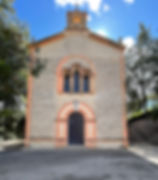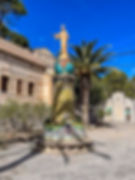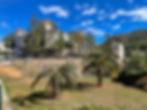Sanatori Fontilles - leprosy hospital - leprosy museum and historic buildings
- Admin
- Nov 22, 2024
- 4 min read
In the mountains a couple of miles inside the coastal town of Dénia on the Costa Blanca lies what is today Europe's only remaining hospital for leprosy. When you walk around the area with the abandoned buildings enclosed by a high wall, it's like going back in time 120 years. Although the buildings are now dilapidated and the gardens overgrown, it is easy to imagine what it must have been like to live with leprosy here in the days when everything was kept in order.

It is impossible for us today to fully understand what it must have been like to be brutally removed from family and friends and placed in a hospital far away from people for life. When the hospital Sanatorio San Fransisco de Borha was opened in 1909, there was no treatment for leprosy, and the disease lasted for life. The only measure society had was to isolate the sick to prevent them from infecting others.

Naturally, leprosy was associated with fear and shame. The lepers were ostracized and socially isolated. This is what the priest Padre Carlos Ferris and the lawyer Joaquin Ballester decided in 1902 that they wanted to do something about. They wanted to create a place where lepers could live a dignified life and receive the best treatment available at any time. The Spanish were lucky. In many other countries, lepers at the time were put into prison-like buildings where they received food and care, but little else.


Carlos Ferris and Joaquin Ballester managed to raise enough money to create an institution that would not only take care of the purely medical needs of the patients, but also social, human and spiritual needs. The patients were given the opportunity to use their resources for farm work, handicrafts and art. During the 1930s, the small "village" with over 400 inhabitants got a church, theatre, cinema, cafeteria, carpentry workshop, forge, hairdresser, bakery, printer, shoemaker and other functions necessary to be as self-sufficient as possible.

The initiators wanted the patients to live in beautiful surroundings. They should get plenty of fresh air and a nice view. The buildings were to be architecturally beautiful and adorned with sculptures and other art. They succeed in that.

There is little doubt that the patients were doing as well as they could at this time. But they still lacked what is perhaps one of the most important things in life after all - freedom. If they were to get a girlfriend or boyfriend, it would have to happen among the other patients. Some made it, most didn't. If they were to go for a walk, it had to be within the institution's boundaries. They would never be able to travel or experience other things. The only thing that could give them this freedom back was a curative treatment, and it would take many decades before they got that.


Today, as I said, gardens and parks are overgrown and the buildings are characterized by decay and poor maintenance. The hospital no longer has leprosy patients admitted, but still provides outpatient treatment for difficult cases that other hospitals need help with. The hospital also assists poor countries in Asia, Africa and America with leprosy treatment. A few of the old leprosy patients still live in the area because they wanted to, and because it would be too difficult to integrate them into a society they have not seen since they were young. But otherwise, some of the buildings have been put into use for other patient groups.



The first medicines that could slow down or alleviate the symptoms of leprosy came in the period 1945-1966. As a result, more people could be treated on an outpatient basis and fewer needed isolation and admission to hospital. After a combination treatment with three different antibiotics was introduced in 1982, it also became possible to cure the disease. Today, therefore, much of the fear and shame is gone in our part of the world. However, it exists in many poor countries where leprosy is still a major problem.


Leprosy is considered a disease of poverty. This is because the infection primarily leads to illness in people who are poorly nourished and whose general condition has weakened. Many of the staff who cared for the patients at the time when there was no treatment were infected, but since they were in good general health, only a few of them became ill. The vast majority developed resistance to the disease and became immune.


Today, Sanatorio Fontilles and Sanatorio San Fransisco de Borja are historical monuments that are an experience to see. The gardens, parks, terraces and buildings are still there. So does most of the 3-4 meter high wall that was built around the large plot of land in the period 1922-1927 after strong pressure from the local population outside. It is somewhat reminiscent of the Great Wall of China.


The large clock in the area always shows at 7. Then time stopped in this area. But the sundial below the clock still follows the course of the sun. It gives a little hope. Maybe one day someone will come and take pity on the area, refurbish the houses, weed the gardens and start the clock and time again.

More excursions: www.turideer.com
Excursion of the week: Sanatorio Fontilles and Sanatorio San Fransisco de Borja - leprosy museum and historical buildings.
Suitable for: Anyone with a bit of an interest in history.
Admission: Free admission. Open from 08-18 on weekdays and 09-14 on Saturdays and Sundays. Show respect for the few residents who still live there.
Finding your way: Follow the A-7 from Alicante to the main exit for Dénia where you take the N-332 towards Benidoleig. Continue east and at the first roundabout turn west onto the CV-731 towards Benidoleig. Drive through Benidoleig and Orba. After Orba, turn right onto CV-718. Follow this road through la Plana and on until you see signs for Sanatori Fontilles, which you follow until you reach your destination. Alternatively: Enter Sanatori Fontilles in Google maps. Then you will come straight to the place.
